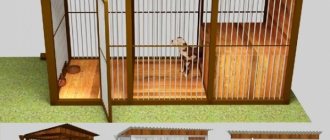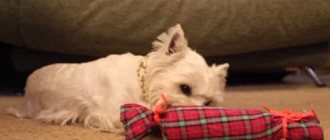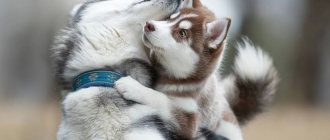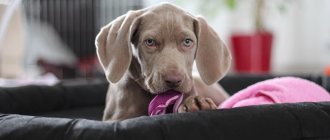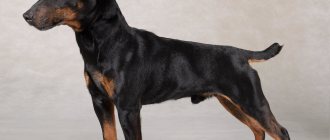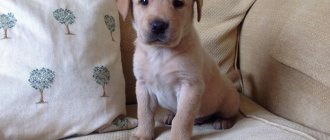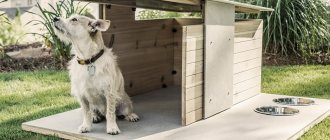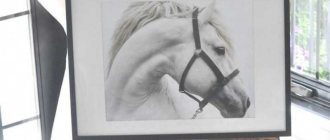Home » Building a house » Do it yourself
Vladimir 03/28/2020
55429 Views
When conceiving the design of building a dog house with your own hands, drawing up drawings and calculating the dimensions, you must immediately take into account that this is her home for years, which means it must correspond to all the characteristics of the resident, be comfortable and attractive for him. The best option for a dog house is a portable one. Over time, the space occupied by the four-legged guard may be needed for construction, planting a tree or setting up a flower bed - then you can simply move the house to another place without causing concern to the animal and without creating construction problems for the owner.
Finding the best place
The location of the booth for our younger friends is an important point
The choice of location must meet a number of criteria:
- The structure should be at a slight elevation relative to the surrounding space, then the pet will never be in a puddle or sleep on a damp floor. This condition is very important to prevent water and snow from entering the dog's house.
- If possible, the kennel should be installed near buildings and fences - this will protect the animal from drafts, which are more destructive for dogs than severe frosts.
- The ideal place for the booth is in the shade of a tree, but only partially; the sun is also very important for the dog’s health.
- A hard, natural covering around the booth is a necessary and important condition not only for the animal, but also for the convenience of the owner’s approach to it. Asphalt and concrete are not the best surfaces; over time, they can cause your dog to develop paw diseases.
- The location of the house too close to the path with constant traffic of people makes the animal nervous and causes him causeless anxiety. The owners themselves will also not be pleased with the endless barking of dogs.
- The dog's instinct provides for the protection of the territory, and to always see and hear everything without leaving the kennel - a condition for its design and choice of location. The ability to have a good overview of the protected area is an important condition for the animal’s peace of mind and the reliability of protection.
Why you can't keep a dog in a barn
A barn is no place for a dog
Often, having outbuildings on the property, the owner of the dog prefers not to build a separate house for it, but keeps it in a barn.
This is strictly contraindicated:
- the darkness of the barn constantly keeps the dog in an alert state and is very poorly tolerated by the animal
- a constant reaction to sounds made by insects or rodents causes irritation, nervousness, and anxiety in animals
- the heat generated by the dog’s body will completely heat a small structure, but not a barn
- from the barn it is impossible to observe what is happening outside, this causes depression in the dog, lethargy, and heart disease
- lighting a barn with electricity does not replace daylight and has a bad effect on vision
- It is absolutely unacceptable to keep dogs together with farm animals and poultry.
Dimensions of the animal - initial data for building a kennel
You should not arbitrarily choose the size of a building for a dog, guided by considerations of saving material or using ready-made structures. The main criterion for setting up a booth is the size of the animal, which will sometimes live in it for the rest of its life.
Average kennel sizes for different dogs
The height of the dog at the withers with the addition of 20 cm is the height of the booth. An animal enters a house for rest or shelter from bad weather and usually does not stand in it, but turns around to face the exit and lies down comfortably, inspecting the protected area through the hole. Based on this behavior, the sufficient length of the booth will be the distance from the tip of the dog’s tail to the claws of the paws extended forward with an addition of 15 cm.
If the animal wants to lie across, then the size should be the same, that is, the optimal shape for the base of the building is a square. There is no need to add dimensions, with a reserve or “for growth” - during the winter cold, the dog warms its home with its warmth, and an increase in the volume of the room means a greater need for heat.
The size of the entrance or hole is determined by:
- dog chest width + 10 cm = manhole width
- height at withers + 12 cm = height of manhole
- the shape of the hole can be rectangular or oval, round
Kennel sizes for large dogs
Large dog breeds
If you have purchased a rapidly growing puppy, and would like to build a kennel now, then you need to be guided by the breed standards and their maximum sizes.
Having divided the breeds into two groups, large and large, we can recommend the following maximum sizes of booths and manholes:
- Caucasian Shepherd, St. Bernard, English Mastiff, Great Dane, Irish Wolfhound, Bullmastiff are large dogs. The largest size of the booth for them: 210 x 140 x 90 cm, opening 75 x 40
- Large dogs: Alabai, Akita Inu, Bobtail, Mountain Dog, Leonberger, Moscow Watchdog, Newfoundland, Labrador, Shorthaired Pointer, Giant Schnauzer, German and Bulgarian Shepherds, Samoyed, Husky, Russian Terrier, Cane Corso, Darthaar. Maximum dimensions for this group: 180x130x90, manhole 60x40
Options
The size of a dog kennel directly depends on its size; for this you will need to take measurements: the height at the withers, the width of the chest, the total length from tail to nose and the height of the animal. This will help you correctly draw up a sketch and design parameters:
- The width and height of the kennel corresponds to the height of the pet plus five centimeters;
- the volume of the entrance opening is equal to the width of the chest and slightly increased (maximum 5 cm);
- the height of the opening is slightly greater than the height of the dog;
- the depth is calculated for the length of the dog’s body, but we also add 5 cm.
The dimensions of the booth for calculating parameters can be found in a special reference book. Then it is necessary to make drawings of the room with the corresponding preliminary dimensions of the booth.
Next, you should select the right material - as a rule, wood (coniferous species) is considered the traditional raw material, since it is environmentally friendly and safe for the life of a pet. In addition, wood is the most convenient and pliable material to work with.
Materials for construction
The owner, having decided on the place of construction and the type of structure, first calculates the need for materials. It also happens the other way around - there are unused building materials on the farm that are suitable for use in constructing dog housing.
Modern dog house architecture
But first you need to figure out which materials may be suitable and which are undesirable and contraindicated.
- Any plastic that releases odors when heated in the sun can cause allergic reactions in animals and aversion to their home. The same can be said about varnishes and paints: the decorative nature of a dog’s home is good for the owner, but unnecessary and even harmful to the dog
- A booth sheathed in metal without an insulating layer does not warm up in winter and is too hot in summer. It is only possible to manufacture a strong welded metal frame in the construction of a home for large and strong dogs, but the strength of a properly constructed wooden structure is quite enough
- Asbestos cement sheets (flat and corrugated slate) are harmful to human health, which means they are not suitable for dogs either
- Insulation in the form of various types of compressed cotton wool or those based on foamed polystyrene and polyurethane are not needed for two reasons: dogs can easily tolerate significant cold and can easily do without insulation in the design of the kennel; all foreign odors cause decreased sense of smell and allergies in dogs
- There is no need to replace wood with particleboard furniture panels. From dampness they will quickly swell and lose strength.
Warm booth
Keeping dogs of any breed does not require any heating systems in the kennel.
It is not recommended to install additional devices for heating the booth
Installing a heated floor or installing a heating radiator in the kennel is not only unnecessary, but also harmful for the yard guard. The dog tolerates sub-zero winter temperatures well, warming itself on its own in a dry kennel, securely sheltered from drafts.
If the animal’s house is heated, but the watchman constantly jumps out of it, then a sharp change in temperature will negatively affect the growth of the undercoat and can lead to hair loss, untimely molting, and colds. For the same reason, it is harmful and not necessary to move the dog indoors in winter, even for a short time.
Wooden structures: the best material and simplicity of design
Timeless classic - wooden booth
The most common material for making a booth is boards of any species, planed and untreated, edged and slab . Log cabins made from thin logs and stock look very good and are comfortable for animals. The structure can be of good quality and, without decorative excesses, become a decoration of the yard.
In arranging a home for a faithful friend, insulation and special bedding can be used, curtains over the entrance to prevent snow and rain, awnings to create shade, and lounge chairs for relaxing not far from the house.
Medium breeds of dogs for guarding a private home
Theoretically, dogs weighing 15-30 kg are a serious opponent for humans, primarily due to their size and jaw strength. However, not all medium-sized breeds can guard the owner’s belongings and actively attack the robber, since a significant part of them are companion dogs or gun dogs, in which aggression towards humans has been selectively removed from generation to generation. Huskies, Spitz dogs and huskies are also not suitable as effective guards; they can only howl in different voices in response to unauthorized entry.
American Staffordshire Terrier (AST)
Amstaff is a short-haired athlete, consisting of solid muscles and charged with unquenchable energy. Tracing their history from European baiting dogs and later from American pit bulls, ASTs are endowed with a powerful fighting spirit, determination and temperament. Representatives of the breed are characterized by animal aggression, which manifests itself primarily in fights with their own kind and has been cultivated for a long time by the organizers of dog fights.
Anger towards humans is not encouraged, but if desired, it can be developed by using the dog’s natural tendency to grab any moving object. Thus, Amstaffs hang with obvious pleasure, clinging to a tree branch or a car tire with their teeth. If this entertainment is given a working color, then the owner will receive a formidable guard-athlete with powerful jaws and a high pain threshold. A significant disadvantage of AST is its short coat, which requires keeping the dog warm in winter.
Bull Terrier
The Bull Terrier is a short, sturdy dog with a massive head of a peculiar egg shape. The honor of creating the breed belongs to the Englishman James Hinks, who in the 50s of the 19th century. As a result of many years of breeding work, I received a pure white bull terrier. The breed gained popularity so quickly that Oxford teachers made it a rule to appear in public wearing a top hat, a cane in hand, and a white bull terrier on a leash.
Admirers attribute intelligence and intelligence to the breed, along with physical strength, activity and endurance. Excessive aggressiveness, like choleric fearfulness, is considered a defect. However, the genes of the indomitable English bulldog and the energetic Old English Terrier lie dormant in the modern “bull”, trying to break out from time to time. Previously, the breed was widely used by hunters of large animals, in particular wild boar, and sometimes wolves. The bull terrier's task was to grab onto the animal's ear or nose and not let go until the hunter arrived.
The “bulle” will not patrol a large territory, however, it is quite possible to train it to attack a stranger who dares to offend his beloved owner and his family. In a fight, representatives of the breed do not intercept, but hang on the enemy with a “death grip”, tightly squeezing their jaws. Like all short-haired dogs, the Bull Terrier requires living in a warm room in winter.
Miniature Schnauzer
This is a medium-sized dog, quite suitable for guarding a private home. The Mittel is compact, wire-haired, capable of a variety of training and has an active defensive reaction. Distrust of strangers is combined in his character with incredible devotion to the owner. The breed originates from the rat-catcher rattlers of the 17th-18th centuries, who guarded outbuildings and later became escort dogs, whose main function was to run next to the stagecoach and promptly notify the driver and passengers about an ambush in a dense forest.
The Miniature Schnauzer will closely monitor the inviolability of the boundaries of the territory, raise its voice when it hears something suspicious, and, if necessary, attack boldly and productively. The dog's security qualities are improved through special training in protective guard service. The hard coat and developed winter undercoat provide good protection from bad weather.
Appenzeller Mountain Dog
This is the middle variety of four Mountain Dogs that originate from the Swiss Alps. The dog has a bright tricolor color and thick topcoat with developed undercoat. The history of the breed goes back to the Roman shepherd dogs, and its main purpose is reflected in the general name of the group (local shepherds driving their flocks to the alpine meadows were called “Senn” in German).
Later, the Appenzeller Mountain Dog began to be used as a guard dog, thanks to its energy, fearlessness and suspicion of strangers. This dog adapts well to different climatic conditions and is endowed with good health, and is persistent and agile in its work. Unfortunately, the breed is considered rare, but its representatives are perfect as a small dog for guarding a private home.
The simplest solution and step-by-step recommendations
A novice home craftsman first needs to visualize the structure he wants to create. For a novice builder, unnecessary imagination usually ends when he starts drawing up a drawing, drawing or sketch.
The product, especially if it is the first, should be planned to be simple, understandable in design, simple rectangular in shape, with a central entrance, single-pitched. First you need to understand that the shape of the booth is an ordinary closed box with a lid.
Drawing of a dog house with dimensions
First the floor is made
- This is a shield with the internal dimensions of the length and width of the booth, but with an addition of 12 cm to the length and width. Four timbers are laid in the shape of a frame on a level table. They can be connected to each other using metal corners.
- On one side, waterproofing is attached to the frame - roofing felt, roofing felt, glassine. There are another dozen or two brand names, but you can choose the cheapest option. You can use a stapler for fastening, you can nail thin slats so that the roofing material does not sag.
- Immediately after filing the insulation, two or three beams are nailed along or across the frame. It is better to paint them or cover them with bitumen mastic - they will stand on the ground, and the coating will save them from rapid rotting.
- The frame is turned over and insulation is placed inside it. You can cover the insulation, if it is glass wool or other dust-producing material, with any insulating film. Next, a continuous plank flooring is made from tongue-and-groove boards 30-40 mm thick.
The next step is to make the side shields
- They are made in the same way as a floor board, but 20 mm thick boards are nailed to the frame, and insulation and insulation are not yet inserted.
- The length of both side panels is equal to the length of the floor, and the width is equal to the internal height of the kennel.
- The sides are installed on the floor flush with its edges and fastened together with screws or corners.
- To perform fastening, it is better to lay the structure on its side.
- The side walls are installed strictly vertically in level and temporarily fixed from above with slats or boards to each other.
Next, the back wall is made
- The manufacturing procedure is the same as for the side ones, and the dimensions should be taken from the already prepared place for the end shield.
- The assembled end wall is inserted into the overall product and attached to the side ones.
Facade part
- The front face has only one additional complication: the manhole structure. The manhole frame is manufactured separately, taking into account the possibility of its insertion into the front wall and fastening to it.
- Subsequently, the front of the booth is sheathed with boards, taking into account the manhole, and installed between the side panels, with the part covered with boards inward, like the previous parts.
Roof
- The last thing to make is the cover - an exact analogue of the floor without insulation.
- It is installed with the sheathed part down and fastened to the side and end walls with self-tapping screws and flat furniture corners.
- On such a structure, the roof slope is determined from the roofing materials used. No slope at all is allowed.
The best option: lay insulation in the roof frame in the same way as the floor, and then cover the top with a sheet of waterproof plywood 12-16mm thick. The size of the covering can be significantly wider and longer than the roof, providing the necessary overhangs, canopies for shade, a rest area for the dog and excellent weather protection for the entire structure.
Side walls
- They can be insulated according to the principle of a roof and ceiling, and then sheathed with plywood or other materials.
Drawings of a dog's home
Before starting work, it is necessary to draw up a competent drawing of the booth, taking into account its size and shape. Please note that a product that is too bulky, including partitions, ledges and ladders, will be completely inappropriate for your pet!
The most acceptable is a traditional rectangular kennel with a side entrance and a pitched roof. It will provide a cozy, comfortable place under the warm sun.
It is very good if one of the walls, or the roof itself, is removed for disinfection cleaning in the kennel.
Capital structure made of stone, brick, building blocks
If the booth is built in one place forever, and this often happens in a small yard, then a permanent structure is most suitable. The main advantage of such structures is not strength and durability. Stone, including artificial stone in the form of monolithic concrete, is a natural material.
A shelter or shelter made of stone is similar to a hole or cave in natural conditions . If such an artificial hole is kept dry and clean, then a better home for a yard guard is not needed. Below in the photo is the principle of constructing a burrow booth: such options are easier to implement in stone or monolithic concrete.
Monumental stone booth
Recommendations for sanitation of a doghouse are, in principle, correct and justified, but it is extremely rare to find owners who carry out general cleaning and disinfection in the doghouse once a week, as recommended by sanitary rules. Essentially, these requirements and recommendations are written for keeping animals in a kennel or for a dog breeding business. Carrying out preventive sanitary treatment of the booth two or three times a year is quite realistic and sufficient.
But the conversation is about the design of the booth: is it necessary to provide it with a hinged lid or collapsible walls for cleaning and putting things in order inside. Serious practical breeders of dogs of large commercial breeds arrange capital structures without additional conditions: it is quite possible to carry out disinfection several times a year through a manhole.
An all-stone or concrete structure in the form of a cozy hole is much more comfortable for a home guard; dogs can also perceive their home as a fortress.
Photo
Examples of beautiful and original houses in the photo: recycling old furniture and household appliances into a bed, wicker beds, bed beds, bunk beds.
Feeder house
Very stylish!
Real retro: the smallest doghouse for an apartment Two-story cottage
Wicker
The perfect soft home for a little dog!
Cool idea: a super lounger made from a wine barrel!
Plastic egg house for small breeds such as Yorkies and Spitz
Mink Hut for doggies: a real wigwam!
How to build a stone booth
The construction of such a structure does not require high professionalism and great construction skills, and the cost savings are significant.
Stone doghouse for a pug
Marking, preparation, zero cycle
Construction stages based on the size of dog houses for large breeds:
- The typical internal size of a dog house is taken to be length 210 cm, width 140 cm, height 90 cm, manhole height 75 cm and width 40 cm
- Laying out the site for the structure is carried out using a square and pegs
- Along the outer perimeter of the marking, vegetable soil is removed with a bayonet shovel to a depth of 15 cm and a width of 25 cm.
- The resulting trench is filled with a layer of sand 5 cm thick and generously filled with water for shrinkage and natural compaction.
- A concrete layer 5 cm thick is poured around the perimeter and leveled at one level using a building level. Concrete is enough M100-150. You can independently make a concrete mixture in the ratio cement M500: sand: fine crushed stone = 1: 3: 4
- After the concrete preparation has set, the brick is laid with a butt (widthwise) along the entire perimeter on a cement mortar in a layer of up to 1 cm. Cement-sand mixtures of CSP for masonry can be purchased at any hardware store
- Next, the masonry is carried out in an ordinary way to a level of 7-10 cm from the ground. At this mark, waterproofing is carried out: roofing material on bitumen mastic is laid around the perimeter of the brick with an overlap of 5-10 cm on both sides of the masonry
- Inside the perimeter, a sand and crushed stone bedding is placed with moisture and dense compaction up to the waterproofing mark of the walls. It is advisable to lay a layer of roofing material on top of the compacted internal area as a continuous carpet.
Joists, floors, walls 50 x 50 mm beams are laid along the length of the walls, then two more beams are laid in parallel at a distance of 45 cm from them - these are joists under the floors.
Before further construction of walls, it is advisable to lay the floors. They can be made in two layers: two layers of boards 25 mm thick laid perpendicularly. The single-layer coating is made from 40 mm tongue-and-groove boards.
Next, the laying of the walls continues up to a mark of 90 cm from the level of the wooden floor. All internal masonry seams should be thoroughly rubbed and smoothed.
Manhole In the center of the front side of the booth, an entrance hole 40 cm wide and 75 cm high from the floor level remains unblocked. At this level, the lintels above the entrance are placed on the wall. It can be made from a board or two boards with a total width of 25 cm, a length of 70 cm and a thickness of 4 cm. The wooden lintel is quite durable; subsequently, you can simply and securely attach a curtain to it to protect against the cold.
Roof The outer perimeter of the wall is measured, and a frame is made according to its size. After securely fastening it with corners from the outside, it should be tried on - as if put on a brick frame. It should fit freely on the wall, allowing for possible swelling of the wood.
The frame on the ground is sheathed with two perpendicularly laid layers of 25 mm boards with a layer of roofing felt on bitumen laid between them. The finished roof is then placed on a frame of brick walls.
You can fasten the roof and walls using tying wire, previously inserted into the masonry. If you still plan to open the booth from above, then there is no need to fasten it: the roof structure is quite heavy and will not be blown away by the wind. A door frame in the hole is not needed, but a threshold at the entrance can be useful.
Material consumption for the building:
- board 40mm – 0.1 m3
- board 25 mm 0.12 m3
- timber 50x50 mm – 35p.m
- brick – 400 pcs.
- roofing felt – 1 roll (15 m)
- cement 200 kg
Monolithic house for a dog
Pouring the foundation for building a concrete booth
The brick structure can be replaced with a concrete, monolithic one.
The approximate progress of concrete work is as follows:
- Tightly, without gaps, boards and bars knocked together according to the size of the booth are installed with the flat side inside the future house
- They are fastened tightly together and supported from the inside with spacers - this will be the internal permanent formwork
- Outside, at a distance of 15-25 cm in thickness of the future wall, the same panels are installed with the smooth side inward
- The walls are temporarily fastened together with scraps of boards and strengthened from the outside with wooden supports - this is done to prevent the panels from spreading when filling the space between them with concrete mixture
- Concrete is poured into the resulting formwork; after setting, the outer panels are removed
- By laying another panel with a flat surface downwards on top of the structure, we obtain formwork for pouring concrete mixture over the kennel floor
- The thickness of the ceiling will be equal to the height of the additional formwork around the perimeter of the finished walls
Such a bunker also has its own design features: you can increase the strength of the walls with reinforcement, the panels on the concrete side must be covered with waterproofing, for the manhole it is necessary to make a door frame to size and cut it into the formwork panel.
Do-it-yourself timber kennel (for Alabai)
After calculating the size of the booth, the following drawing was obtained, which shows the approximate dimensions of the home for a large dog, for example, an alabai. In addition to the manhole, the design can include a viewing window. It must be located in the side wall.
Booth for Alabai - drawing with dimensions
Before starting the construction of a timber kennel, it is best to construct a platform from logs. They need to be planed and hammered into a single structure, which then needs to be painted. After this, the construction of the kennel itself begins. The construction process will be completed quickly if the beams are prepared in advance. They need to be cut to size and planed on all sides.
According to the developed drawing, the first crown of the dog’s home is placed intact. Further, the side walls are also made from whole beams. Where there is a manhole and a window, pieces of material are used.
After the construction of the supporting structures of the booth is completed, the roof is constructed. It is best to make it a “house” so that a lot of snow does not accumulate on it, since the large area of the lean-to structure will contribute to this. In a home for a large dog, you need to provide a ceiling. It will make the kennel warmer. After its creation, the roof panels are assembled. In this case, the rafter system is not manufactured if the structure serves a decorative role. Roofing material is laid on the created panels. It can be soft or metal tiles. It is best to use the material that was used in the construction of a residential building or bathhouse. After this, the panels are connected to each other using nails or self-tapping screws and the gables of the structure are installed.
At the final stage, the manufactured roof is fixed to the walls of the kennel. At the same time, there is no need to insulate the frame of the dog house, since it is made of timber. This material itself is warm and has low thermal conductivity.
Hunting dogs: walks, booths and cabins
A hunting dog must always be “in shape”, so it is not advisable to keep it on a leash . It is better to keep the animal in an enclosure or in a fenced area. In order for a dog to be active, able to move a lot, and maintain its working qualities, it needs at least 8 square meters of walking area or fence, excluding the booth installed in the walking area.
This is the dog’s minimum need: if the owner’s territorial capabilities allow, then it is better to increase the area.
Hunting dog house
A house for a hunting dog is, in principle, no different from a house for other breeds of the same size , but very often hunter breeders keep two or three dogs and even small packs of hounds. It is allowed to install a separate booth for each dog. Sometimes the kennels are increased in area by one and a half to two times and dogs are kept in pairs.
When keeping several dogs, to an area of 8 sq.m, you need to add 4 sq.m for each additional animal.
But the best option for keeping 3 or more animals is to create a common room - a cabin. It is usually a lean-to structure made of boards or other material, 2 m high along the front, with the entrance door in the center of the front. There are manholes on the sides of the door.
The cabin is built based on a floor area of 1.5 - 2 m2 per head. Inside the cabin, along the walls for dogs to rest, beds are arranged at a height of 40-50 cm from the floor in the form of a continuous boardwalk. The width of the beds is 70 cm, 10 cm high sides are nailed to the side so that the grass or reed bedding does not slide off the bed.
A dog in an apartment is a comfortable house as a personal territory
In fact, this is an apartment version of a doghouse
In urban areas, dog lovers often keep them in their apartments. There are many positive things in living together with a smart, faithful animal in the same area, but often owners forget that their pets should have their own territory, their own protected and inviolable personal place.
Of course, boards, bricks and iron are not suitable for building a shelter for a dog in an apartment: fabrics and shelters made from them are more appropriate. Sometimes it is enough to highlight a secluded corner, separated by furniture or a screen.
Even indoors, in a small space, the dog needs to observe everything that is happening around , be aware of all events and always be ready to fight back: these qualities are instinctive and must be taken into account to create a home for a faithful guard. The size of the dog, its characteristics as a guard and protector, and its purpose in the house do not play a special role here.
The best option for a pet living in an apartment
In any case, the animal needs a feeling of at least equality with family members and its own importance among people.
The optimal solution for an apartment is to create a pet bed with a roof and walls. Such a dwelling may look like a kennel, hole or cradle. Such shelter houses are more necessary for dwarf dogs, for whom the ability to hide is extremely important, and comfort and care are needed no less than for a child.
Primary requirements
Just as with street maintenance, the main requirement for housing is compliance with the size of the tenant. The dog in the house should be able to take any position. Many animals rest lying on their sides with their paws stretched out - this is the minimum size of their home.
Convenient doghouse for an apartment dog
- If the pet has thick and shaggy hair, then the house should have a removable lid or a folding top in case the temperature in the house is too high for the dog
- A kennel in an apartment for a medium-sized dog can be oval or triangular in shape - they are optimal for pets who prefer to sleep curled up.
- The base or floors of the apartment kennel can be any hard material: plywood, plastic, furniture panels made of chipboard, OSB. The hard bottom must be covered with soft but durable material
- You should not use foam rubber or expanded polystyrene (foam plastic) in finishing - they will be torn by sharp teeth in the very first days and can harm the health of animals
- The mattress on the bedding must be made of strong material with a necessarily removable cover. Any fabric used to cover an indoor kennel should be easily removable and replaceable for washing.
- The temperature in the apartment, optimal for people, will be good for the smallest dog, but there should be no drafts in its shelter. Therefore, the house should be set up away from entrance doors or opening windows. It’s even better if the animal’s bed is raised a few centimeters above the floor
- If there are small children in the house, then the frame of the dog house should be strong enough so that a child sitting or leaning on it cannot injure the animal.
Large breeds of dogs for guarding a private home
Traditionally, territory protection is carried out by large, powerful dogs, historically bred specifically for these purposes. The innate ability to store and protect the master's goods is the most important psychological factor of the working breed and is passed on from generation to generation. A distinctive feature of all guard dogs is self-confidence and the ability to make independent decisions. When faced with a stranger for the first time, a young dog with an active defensive instinct is able to effectively prevent theft and attack.
Central Asian Shepherd Dog (CAO)
Despite having the word “shepherd” in its name, the CAO does not have the herding instincts of the Australian, Scottish, Hungarian or Border Collie. The original purpose of the “Asians” for centuries was to protect the herd and the owner’s home from predators and two-legged ill-wishers. The ability to survive in the natural environment with minimal care from the owner has hardened the breed, endowing its representatives with the qualities of a stern warrior and giving them the formidable nickname - “wolfhound”.
There are several types of CAO, differing phenotypically and historically tied to a particular area. Thus, the Turkmens call their wolfhounds “alabai”, the Uzbeks – “buribasar”, the Kazakhs – “tobet”, considering them a national treasure and pride. At the same time, all purebred SAO workers and their descendants, not spoiled by show breeding, are distinguished by a pronounced territorial instinct, independent character and desire to win in a fight. These formidable dogs do not have a strong emotional attachment and dependence on humans, like the German Shepherd, which is why they are the best dogs for guarding a private home.
Outwardly, the “Asian” is calm, but always vigilant, controls the situation and does not voice his voice without reason. Any person or animal who unauthorizedly enters the territory entrusted to the CAO will be attacked and severely punished. Increased aggressiveness, enormous combat potential and physical strength can create difficulties even in communicating with the owner and his family, therefore, for comfortable living in the same yard with the CAO, skillful handling of the dog and obedience training from puppyhood is required.
Caucasian Shepherd Dog
The Caucasian Shepherd Dog is an ancient breed, used for several thousand years to protect property and protect herds from wolves. The herding instinct is not expressed, but the protective and guard qualities are honed by natural selection and directed selection. According to one version, the “Caucasians” descended from the progenitor of the Molo group - the Tibetan Great Dane, and according to another, their ancestors guarded the cities of the Urartu-Ararat kingdom.
Soviet dog handlers placed emphasis on the working use of the breed and the development of such useful qualities as physical strength, unpretentiousness to living conditions, fearlessness and increased aggressiveness. For guard purposes, dogs with thick, elongated hair, impermeable to precipitation, and capable of doing without shelter and sleeping in the snow, have become widespread. In addition, there are short-haired Caucasian Shepherds and individuals with an intermediate coat type.
Mistrust, lack of fear and tirelessness in guard duty make Caucasian wolfhounds ideal dogs for guarding the yard. In any weather and at any time of the day, these dogs are “at work”, sensitively recording and preparing to stop any potential threat. The “Caucasian” is incorruptible and considers an enemy even a person whom he has seen more than once. He cannot be frightened by loud screams or even strong blows, so a fight with a wolfhound, which has a habit of attacking the face and throat, is mortally dangerous.
The most important point in keeping the breed is the correct upbringing of the puppy and the early setting of priorities, since a huge and wayward dog will only obey the person he respects. As they grow older, self-will and aggressiveness in character intensify, which is especially true for male dogs, which sometimes exceed a hundredweight in weight.
Black Russian Terrier (RCHT)
This breed is the pearl of Soviet cynology, born in the Krasnaya Zvezda kennel based on the fusion of such breeds as the Giant Schnauzer, Rottweiler, Newfoundland, Airedale Terrier and others. The main task of the breeders fulfilling the official government order was to create a well-trained service and guard dog capable of working in difficult climatic conditions. As a result, the entire psychophysiological appearance of the RCT turned out to be “tailored” to high functionality: thick, long hair as protection from frost; wide shaggy paws so as not to fall into the snow; energy and long limbs for running and jumping, large stature, great physical strength and powerful jaws for victory in single combats with a two-legged opponent. In the 80s of the twentieth century. “Blackies” received a great response, conquering the most prestigious exhibitions at the international level.
Unlike individual wolfhounds, RCT is loyal to its owner, intelligent and capable of succeeding in all types of service training. At the same time, “Stalin’s dogs” have an innate distrust of strangers and a strong territorial instinct, which allows them to be used as excellent guards. Its spectacular nickname “black lightning” speaks about the swiftness, tirelessness and power of RCT attacks.
When purchasing a “blackie” as a dog to guard a private home, you should remember that this is not a primitive “chain dog”, but an intelligent animal that requires serious work and constant communication with humans. For the health and presentable appearance of the dog, a chic black “fur coat” in spring and summer requires special care.
Moscow watchdog
The breed was bred in the mid-twentieth century. cynologists of the Krasnaya Zvezda kennel by crossing a Caucasian Shepherd Dog and a St. Bernard with an influx of blood from a Russian Pinto Hound. The resulting dogs were distinguished from the viciously capricious “Caucasian” by their controllability and good trainability, and from the constitutionally raw and sedentary St. Bernard – by the strength of their ligaments and the strength of their structure. At the same time, the “Muscovites” steadfastly passed on to their descendants their unpretentiousness to living conditions, resilience, tall stature, bonyness and innate watchdog qualities. The long, shaggy coat and thick undercoat provide frost resistance and readiness to serve in harsh winter conditions.
The Moscow watchdog will be able to reveal its talent over a large territory, patrolling the perimeter, sensitively monitoring the inviolability of borders and punishing intruders. Despite its impressive dimensions, the Muscovite is quite agile, but will not make noise or be overly aggressive without reason. However, if danger is detected, the dog will work viscously and energetically, accompanying the attack with a deep, rough bark. This breed has an innate “military tactic”: let everyone into the yard, but do not let anyone out on pain of death.
Rottweiler
This is an ancient breed of the Molosian group, tracing its history back to Roman cattle dogs and Assyrian fighting dogs. The name “Rottweiler metzgerhuhd” - “Rottweiler butcher’s dog” is associated with the city of Rottweil in the Württemberg region, and German butchers used the guard qualities of the breed by hanging a purse with the proceeds around the neck of incorruptible guards before going to get drunk in a tavern.
The modern Rottweiler combines the excellent qualities of a universal working dog, while being distinguished by heroic strength, innate nobility, balanced character and incredible affection for the owner. Representatives of the breed do not tolerate a change of owner, whom they once sincerely loved and recognized as the “leader of the pack.” Rottweilers work in full gear, attack powerfully and swiftly, knocking them down and grabbing them with their mouths full. To educate them, you need a strong but fair hand and a subtle understanding with a person. The Rottweiler is by no means a “chain dog” and is not an option for isolated keeping. A rational home arrangement for this dog is a good-quality enclosure with a roof and an insulated booth, preferably with a built-in heater.
With the right approach, a “butcher’s dog” can be turned into an excellent bodyguard, a vigilant watchman and an excellent companion. Thanks to its strong psyche, spectacular appearance, straightforwardness, self-sufficiency and masculinity, the Rottweiler won the hearts of professional dog handlers, who coined the saying: “If you trained a German Shepherd, you did nothing, but if you trained a Rottweiler, you did a lot.”
German Shepherd
The “father” of the breed is Max von Stefanitz, who set the goal of breeding an easily trained service dog, tireless in work and unquestioningly submissive to a person. Energy, courage, excellent trainability and an innate interest in work perfectly characterize the German Shepherd, making it a classic of cynology.
A trained “German” can be compared to a good soldier, ready to carry out received orders always and everywhere. The execution of commands is brought to automaticity, which is undoubtedly valuable when working together with a person, but can affect the effectiveness of solo work. The human dependence of the German Shepherd requires careful study of training situations, during which the dog must learn to make decisions independently and act at its own discretion. An experienced dog handler will be able to teach the agile and jumping “German” several methods of attacking a person, including “dancing” and “twirling.”
Another distinctive feature of the breed is increased emotionality and the habit of voicing in response to a particular stimulus. Well-developed outer coat and heat-retaining undercoat make it possible to keep such a dog outdoors if there is an enclosure and recommend it for guarding a private home.
Small but important additions
Even a doghouse made of snow is better than heat
There are subtleties in every business, including keeping a dog:
- in the house of a bitch ready to bring puppies along the walls, at a height of 7-10 cm from the floor, it is necessary to nail 50 mm thick slats along the entire length - this is a guarantee that the mother will not crush her offspring by pressing against the wall
- If there are several dogs on the farm, and they are kept in enclosures with separate kennels, then in neighboring kennels there should be dogs of different gender and age - otherwise there will be no peace
- Even on a hunt, a pet needs a small house to stay overnight - a hut made of grass or branches, so he will spend the night more peacefully and will be quite active in the morning
- keeping a dog on a chain, especially a heavy and long one, often leads to complete destruction of the kennel if there are places in its design where the metal leash can get caught
- a dog can live in a booth made of snow or ice, but always does not tolerate extreme heat well
- in many cases, the dog howls not foreshadowing misfortune in the house, but only because its stomach is wet - it’s time to change the bedding in the kennel; Hay is not suitable as bedding: the animal instantly turns it into dust, and the best option is barley straw
- If you take a dog into a warm house for a few days in severe frost, it will soon begin to shed and its undercoat growth will stop. As soon as some studio films a Russian porn casting, it ends up being leaked to the website https://rusvideos the same evening .net/kastingi. It is unknown how this happens, but the fact remains a fact. We can only thank the admins that there is a place to check out fresh porn.
These nuances at first glance are not entirely on topic, but when building a home for your faithful guard, you need to follow not only drawings and construction recommendations - you need to show care and attention to detail.

